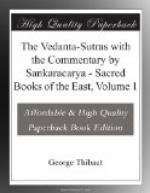How, then, the Sa@nkhya will ask, do you interpret the phrase ’the five five-people?’—On the ground, we reply, of the rule Pa/n/ini II, 1, 50, according to which certain compounds formed with numerals are mere names. The word pa/nk/ajana/h/ thus is not meant to convey the idea of the number five, but merely to denote certain classes of beings. Hence the question may present itself, How many such classes are there? and to this question an answer is given by the added numeral ‘five.’ There are certain classes of beings called five-people, and these classes are five. Analogously we may speak of the seven seven-rishis, where again the compound denotes a class of beings merely, not their number.—Who then are those five-people?—To this question the next Sutra replies.
12. (The pa/nk/ajana/h/ are) the breath and so on, (as is seen) from the complementary passage.
The mantra in which the pa/nk/ajana/h/ are mentioned is followed by another one in which breath and four other things are mentioned for the purpose of describing the nature of Brahman. ’They who know the breath of breath, the eye of the eye, the ear of the ear, the food of food, the mind of mind[237].’ Hence we conclude, on the ground of proximity, that the five-people are the beings mentioned in this latter mantra.—But how, the Sa@nkhya asks, can the word ‘people’ be applied to the breath, the eye, the ear, and so on?—How, we ask in return, can it be applied to your categories? In both cases the common meaning of the word ‘people’ has to be disregarded; but in favour of our explanation is the fact that the breath, the eye, and so on, are mentioned in a complementary passage. The breath, the eye, &c. may be denoted by the word ‘people’ because they are connected with people. Moreover, we find the word ‘person,’ which means as much as ‘people,’ applied to the pra/n/as




